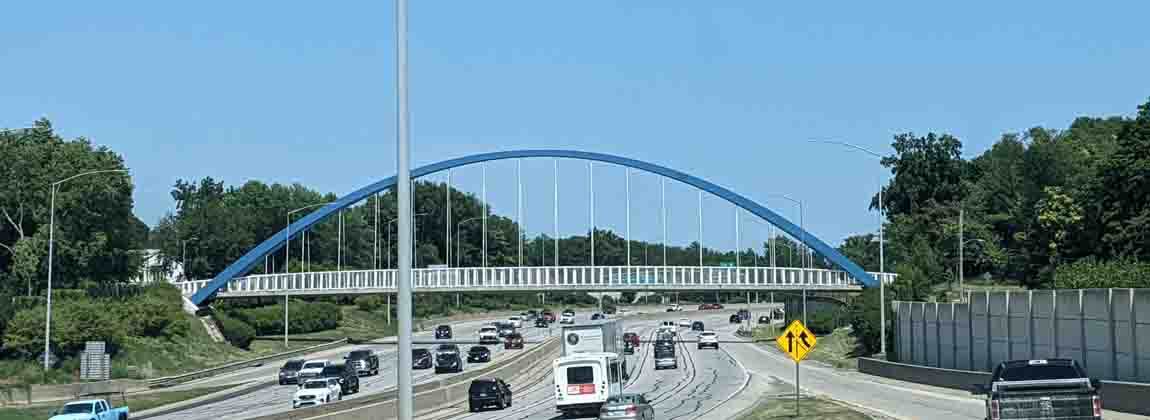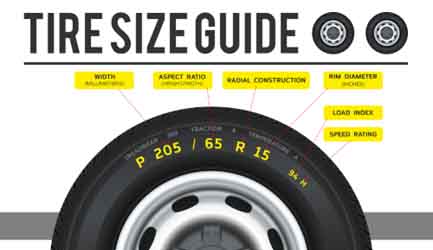What to Know About Your Tires When Living in DSM

Tires are something everyone who owns, rents or leases a car uses regularly. Not everyone who owns their car was responsible for the set of tires put on it when they bought it, but at some point, will be responsible for purchasing new tires. For those who may need to buy a set of tires but aren’t sure what they need to know, this guide will make tire buying a little easier.
Tire Buying Tips
First, know the type and size of the tires currently on your vehicle. There are two ways to find the tire size, the first is to look at the sidewall for a sequence of numbers depicted like the picture below.

The first number you want to be conscious of is the tire width, which is measured in millimeters. The wider the tire, the higher this number will be. The second number is a percentage relative to the width. In this example, the tire is 65% of the width in millimeters from the rim where the tire connects to the top of the tire. That third number is the diameter of your rim in inches. Finally, the load and speed rating are how much weight the tires can carry and how fast they can go at a maximum speed. These last two numbers are important to match because the car was made with these specifications, so the tires will ride the smoothest when they match.
The other place to find your tire size is just on the inside of the driver’s door where the VIN is located, and it will have those same numbers.
Once you know what size tire you have, it is important to consider what type of tire you would like to purchase. Ask yourself what kind of tread you want. This will depend a lot on the type of driving you will be doing and when that driving will occur.
Types of Tires
For the sake of simplicity, I will only talk about the most common types of tires that most people will experience. Touring, performance, all-terrain, all-weather and winter tires.
Touring tires are probably the most common tire you will find. They are an all-season tire meant to be driven long miles on the highway. They maximize comfort, quiet and milage as much as they can. They are common on most cars, sedans, vans and small SUV’s.
Performance tires are for someone who wants handling to be the top priority. They typically have faster brake times and can take corners much more efficiently. They are considered all-season, but mostly meant for wet conditions in summer months. They can have a harder time in the winter. It is not often a tire we offer as a first choice unless a customer specifically wants a certain brand.
All-terrain tires are most often found on trucks. These are the aggressive looking tires meant to be able to handle dirt or gravel roads with ease. You won’t get as good of milage or as quiet of sound, but they have enforced sidewalls that can protect the tire against something you may accidentally bang into (curbs and the like). These are typically used on trucks or a vehicle like a jeep, though can also work for somebody that may take their SUV out for hunting or something similar.
All-weather tires are often confused with the “all-season” designation. All-season is a designation used for touring, performance or all-terrain to let the buyer know they should perform in all seasons of the year (though to varying degrees depending on the conditions). All-weather is its own type of tire that is becoming increasingly popular as places like the Midwest experience less snow than they used to. It is a tire with a tread deep enough to handle a good amount of snow but not quite the same rubber compound that winter tires have that causes them to melt in the summer. It is an excellent hybrid for folks who live in a climate like Greater Des Moines (DSM).
Winter tires, as you might guess, are specifically designed tires for winter months. They provide the best traction in snow. However, the way they are designed is specific to the cold temperatures. If you run a winter tire in warmer months, it will begin to degrade very quickly. This is due to the special rubber compound that allows them to be flexible in cold temperatures. Winter tires almost always come with a distinctive tread pattern that is directional. Direction means it will have an arrow letting the installer know which way the tire needs to rotate. This allows the distinctive tread design to maximize its efficiency. Always double check that this rotation is installed correctly. Unfortunately, it is a common mistake since this kind of installation is not the norm.
When buying tires, whoever is helping you choose should do a dive into your habits of driving and discover the things that are most important to you to pick the perfect tire.
As for the best value tire on the market right now if you live somewhere in DSM, for a typical driver who stays mostly in the city or suburbs, we believe the all-weather tires can’t be beat. As mentioned above, this changes if you have specific driving habits like going off-roading, driving across the state or over state lines regularly, live in the country on gravel roads, etc. For most people, this tire meets almost everyone’s needs. There was certainly a time when owning a set of winter tires was necessary for anyone in the Midwest, but over the recent decade, we have seen less snow and for shorter periods. In that time tire technology has only gotten better, particularly with the all-weather tires which are relatively new. Add to the fact that tire prices have only gone up, and you have fewer and fewer people going the way of owning two sets of tires.
All-weather tires typically come with a good milage warranty with most brands starting at 60,000 miles. For most people, this will last them for several years before they need to get another set of tires (if they do before they sell the car for another).
Their biggest difference maker is their traction in bad conditions. I will talk about myself for a second, I am a transplant to Des Moines from El Paso, Texas. It snowed three times in my life and each time it melted before the day was over. When I got to Des Moines, driving in the snow was a serious learning curve. I’ve gotten much better at it but still have difficulty when there is heavy snow. This past year I switched to all-weather tires and the difference has been unbelievable. The reason they perform so well is the all-weather tire is designated with a “Three Peak Mountain Snowflake” rating. This means it was tested and developed specifically to perform well in winter conditions.
Though the winter tire still has superior performance in the winter months, for the reasons listed above — less snow, rising cost of tires and better tire technology — we believe if you’re going to live in DSM, the all-weather tire is your best choice. Tire manufacturers realize this as well, just in the last five years, multiple large manufacturers have made it a priority to create their own all-weather tire to keep up with the trend.
The last thing to mention about the all-weather tire is the cost. It is not as expensive as your high end, season-specific performance tires. However, it certainly isn’t the cheapest either. I can’t give a cost estimate here because of the extreme variation depending on the exact tire size, but it will be a few tiers higher than the cheapest tire depending on the brand. If price is a big concern, you can ask about a few brands specific to local tire shops that places like Discount Tire or others can’t sell. These can be very affordable alternatives to a name brand tire. It is also worth repeating that you are getting what you pay for. So even though they are more than the least expensive tire; they will last longer, better protect you and make driving easier and safer.
There you have it, a very basic guide to tire buying. This tire guide should be helpful to anyone who needs tires, and the opinion about all-weather tires is specific to anyone living or thinking about moving to the region. Winter driving can be scary, but it doesn’t have to be all bad. Two sets of tires can be pricey, but it can be solved with a good set of all-weather tires.
With the #7 Lowest Cost of Living in the U.S. and a Top Metro for Number of Economic Development Projects (among metros with a population of 200,000 to 1 million), Greater Des Moines (DSM) is a region where you can have it all. Learn more about what it’s like to live here.
Jordan Hildreth
Jordan Hildreth is the Sales Director at Tire Heroes, a mobile tire installation company started in 2020 serving Greater Des Moines (DSM).